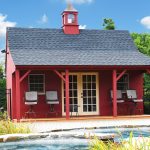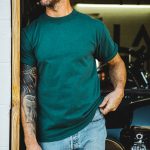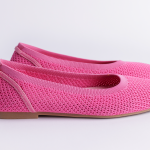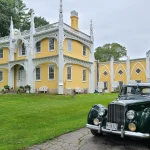The World of Sy Montgomery
The famed New Hampshire nature writer Sy Montgomery dives deep into the animal realm to tell stories that shed light on our own.

Montgomery with some of the many meaningful creatures she’s encountered, including Christopher Hogwood, who inspired her best-seller <i>The Good Good Pig.</i>
Photo Credit: Ian RedmondLong before the 30 books and the far-flung travels to places like Namibia and Borneo; before being stalked by man-eating tigers and courted by tarantulas; before the legions of furry, scaly, slippery friends she would make around the world, Sy Montgomery made a connection when she was 3 years old, a connection with a feeling that would infuse everything to come.
“I didn’t just want to have a dog.” She leans in, for emphasis. “I wanted to be a dog.”

Photo Credit : Courtesy of Sy Montgomery
It is 1 o’clock on a steamy July afternoon. The humidity is mounting, as thick white clouds roll across the sun, and later that day the rain will lash down in torrents, cooling the air. But for now it is as close to jungle torpor as it gets in Hancock, a small historic village in southern New Hampshire, where I, too, have lived. Our paths have crossed for years. We are sweltering in the shade of an old silver maple, so tall it dwarfs the angular white farmhouse that Sy shares with her husband, the writer Howard Mansfield, and their silky border collie, Thurber. Fifty-year-old lilacs lean in. Iced tea glasses pop with sweat, and a bowl of sweet cherries glistens on an old teak table. A spider drops languidly from the brim of my hat. “Look at how brave he is!” she exclaims.
Sy Montgomery, in her natural habitat.

Photo Credit : Corey Hendrickson
A renowned naturalist and science writer, Sy writes with a rare blend of heart and intelligence, sharing her awe and spicing it with humor. In award-winning books for adults and children, she spins true tales of golden moon bears, pink dolphins, baby hummingbirds. Chickens, dogs, and a beloved pig. A 10-pound kakapo parrot that “shagged” her head. “You haven’t felt a good purr until you’ve had a cheetah lying down next to you,” she says casually. At 63, she’s Indiana Jones with a tangle of blond curls, a deep stream of soul, a wickedly good laugh. If you stuck pins in a world map to chart her travels, you’d be jumping from Cape Cod to French Guiana to New Zealand, with sojourns in Africa, India, southeast Asia. A genuine challenge for passport control, flipping through those battered pages.
Meantime, here we are, in Hancock.
More than many, Sy’s travel wings have been clipped by Covid. Last August, she had planned to fly to Ecuador for a book about giant manta rays; October was blocked off for a national tour for her new picture book, Becoming a Good Creature (the children’s version of her 2018 memoir of a similar name). Instead, as airports shut down, then reopened with travel restrictions, she turned her focus to another book project closer to home: turtles. For now, she is fully immersed with the Turtle Rescue League in Massachusetts, along with other turtle projects around New England. Good adventurers find work everywhere.
The evidence is here, in Sy’s first-floor studio, where she writes surrounded by mementos of past “teachers,” as she calls them. Photos of tigers, pigs, pandas. Reference books on poultry, beetles, and killer whales. Toy octopuses heaped beside seashells. When Sy goes in search of a hummingbird nest (“They’re woven with spider webs!”), she first has to nudge a falconer’s glove out of the way.
Some faces stand out. Near Sy’s computer monitor, flanked by an old black-and-white photo of Howard taken on the day of their graduation from Syracuse University, is a framed close-up of a little black Scotty. “My beloved Molly,” she says, her voice softening. “She showed me my destiny.”
Molly’s story is the first chapter in How to Be a Good Creature, Sy’s memoir told through meaningful creatures in her life. “It was hard and scary, digging into the dark stuff,” Sy tells me. While she doesn’t remember much of her early childhood, “I clearly had failure to thrive as a child. When Molly appeared, I finally started to grow. I recognized right away that Molly was finished and complete, while I was still a larva. And she showed me that there was stuff beyond what we can apprehend, an invisible world. There was information Molly could get through scent that I could not smell; information she could hear that I could not hear. It was like [Saint] Paul says, about the evidence of things unseen: You know that other world is there, and that animals are experiencing it.”
Thurber sits at our feet, eyes on Sy. In the quiet of her studio, dozens of tiny jaws are munching. “Hear them?” she whispers. “I love them so much!” Neighbors have asked her to watch over two large mesh containers filled with 50 Polyphemus caterpillars—brilliant green Tootsie Rolls that need regular misting and feeding, and later that day I’ll help clean out their tents and refresh their food. Once they’ve eaten their fill of red oak leaves and undergone their metamorphosis, they will become “big, gorgeous silk moths.” Meantime, Sy unzips one of the containers so I can get a better look. “Angels,” she calls them.
“Stay in there,” she admonishes. “I see your sneaky plan. Don’t want to get anyone’s little legs caught.”
—
A tiger swam after my boat. It could have eaten me, which doesn’t particularly bother me. But a tiger could kill and eat people whom I love…. —Spell of the Tiger (1995)
We settle back under the silver maple, and the day’s steaminess drapes over us. Heat doesn’t bother Sy—“not if there’s an animal around,” she clarifies. “Someone could be nailing my head to the floor and I wouldn’t care, as long as there was an animal to watch. When you’re doing your work, when you’re looking at an animal, or for an animal, or trying to get to an animal, you don’t care that the chiggers are burrowing under your skin, you don’t care that the leeches are sucking your blood, and you don’t care that the mosquitoes are chewing your legs. You just are completely absorbed by the task.”
I nod, and try to discreetly brush away the mosquito that’s been bugging me for the past few minutes.
“It’s funny, though,” she says. “When you’re in bed at home, and there’s an earwig in your nose? That’s when you freak out! I just feel like I’ve had enough bugs in my life, in my work—I don’t want them in my bed!”
In that instant, a ruby-throated hummingbird whizzes by, and we hold our breath. “It’s the first one I’ve seen this year,” she says softly, although she helped raise two orphaned baby hummers while writing her 2010 book, Birdology. “The Aztecs believed they’re reincarnated warriors because they’ll kill each other. God, I love it here!”
For 40 years, she and Howard have lived in this rambling 140-year-old farmhouse, with a barn and a refurbished henhouse (his studio) that fits into the land like a fallen log. Sy happily declares that she and Howard have done as little as possible to the house: “Everybody seems to want to buy an old farmhouse and put in a gigantic kitchen. But I loved it just the way it was.” And she is still incredulous that two young freelancers were able to swing it. “I never dreamed I’d have a home like this. My parents were army—we moved from Germany to Virginia, then Brooklyn, New Jersey. All I wanted to do growing up was survive.”
Her eyes range over the peaceful landscape. Her parents visited once, the night before her wedding to “a tall, skinny Jewish liberal with wild, curly hair,” she has written. “They didn’t come to the wedding,” Sy tells me. “They disowned me, in a letter. But I learned so much from them. My father was an army general who survived the Bataan Death March. And my mother grew up poor, in rural Arkansas, and ended up flying a plane and working for the FBI, so she was tough as nails, too. These were people who knew how to get stuff done. I wouldn’t have had any different parents. I just wish they’d had sense enough to realize that Howard was the best thing that ever happened to me.”
It wasn’t only her parents’ toughness that took hold. When Sy first began reading, her father would search out animal stories for her in The New York Times. In the 1960s, those stories were all about extinction, overpopulation, how elephants were being killed for their ivory, she remembers. “It had a tremendous effect on me. Until then, I’d wanted to be a veterinarian, because that’s what you did if you loved animals. But I began to think I could help more animals as a writer.”
For Spell of the Tiger, Sy traveled to the 3,900-square-mile mangrove swamp of Sundarbans, along the Bay of Bengal between India and Bangladesh. It is the one place in the world where wild tigers routinely attack and eat people. There are no roads, only waterways through the stillness, and the tigers swim so fast they can overtake a boat: “You feel like they’re always there.”

Photo Credit : Nic Bishop
Sy made the trip four times—she pauses—five, if you count the National Geographic documentary she wrote, narrated, and appeared in. In the fading glow of an aging videotape, a slender young woman with untamed blond hair calls out greetings to her friends in Bengali, leans in close as her translator relays questions, examines fresh tracks sunken into thick mud (their own boat has been stalked by a tiger they never saw), and clambers aboard the most fragile-seeming handmade wooden boat, where she stands silhouetted against the setting sun. She, too, might seem fragile, but it’s clear, just by her very presence, that she is not.
“The people in Sundarbans have tremendous natural history knowledge,” says Sy. “They understand what we have forgotten: that we need predators to keep the world whole. They believe in a forest goddess and a tiger god, and they love the tiger with their soul. It’s not hated, it’s feared.” And yet, she notes, tigers are being killed all over Asia so rapidly they might disappear altogether. “If we wipe out the tiger, we murder a god,” she says, her eyes suddenly fierce.
—
I loved travel, I loved exploring, and I loved wildness. But now, in Hancock, with a pig in the barn, I would find the other piece of my heart’s lifelong yearning: home.
—The Good Good Pig (2006)
“Let me show you where Chris lived,” Sy says, and we trot off down the rolling lawn to the barn, past its red sliding door to a pig stall underneath, cut into the hillside. This is where Christopher Hogwood lived and loved for 14 years, in insulated R-22 splendor.
“Christopher Hogwood came home on my lap in a shoebox,” Sy begins her first memoir, The Good Good Pig, a warm-hearted best-seller about a sickly little piglet who defied the odds. The adoption was Howard’s idea—a distraction, or so he hoped, from a low point in Sy’s life. In 1990, her father, whom she’d reconciled with, was dying of cancer, and she was traveling between Hancock and Virginia, spending as much time as she could with the man she had once confessed, in Sunday school, she loved “more than Jesus.” She was also struggling to write her first book, a biography of primatologists Dian Fossey, Jane Goodall, and Birute Galdikas, childhood heroes, but Goodall had stood her up in Tanzania, effectively killing the book’s opening scene. Added to that, the ground was literally shifting beneath Howard and Sy’s feet: The farmhouse, which they’d been renting, was about to be sold, and “no bank wanted to give two freelancers a loan,” she recalls with a grimace.

Photo Credit : Ian Redmond
Chris, a “runt among runts,” not only survived, he thrived. Miraculously, the bank approved their loan. Sy wrote that first book—“from back to front, the last chapters first,” she tells me—and it’s still in print today. Meantime, their family grew. Eight hand-raised chickens, and then Tess, a “classically beautiful” border collie with a troubled past. “My Tess,” she says, touching her wrist. “Some of Tess’s ashes are in my bracelet, and I never take it off.” (None of the octopuses Sy has known have ever tried to take it off either, which is “like magic, because they love trying to take things off.”)
But beyond all that, Christopher Hogwood was a sensation. There was Pig Spa, instituted by two little girls who lived next door, which involved bathing, polishing, and tail detangling. Votes were cast for Chris in town elections. He had fans worldwide and sent out a yearly Christmas card. And there were the inevitable questions. “Does he live in the house?” (“No, but if you saw the inside of the house you might think so.”) “What does he eat?” (“As much as he possibly can.”) “What are you going to ‘do’ with him?” (“We’re certainly not going to eat him. But we might send him abroad for university studies.”)
“He’s buried right there,” Sy points to a small cement pig, half hidden by a tangle of leafy hostas, columbines, and prickers. “It was as far as we could move a 750-pound pig. And it’s why Howard and I both have to be cremated—we have to all be together.”
Among the lessons she learned from him? “Chris showed me how much fun children are,” she says, smiling. “Kids are naturally drawn to animals. They automatically get it that animals are individuals. They automatically know that animals’ lives matter, that they love their lives just as much as we love ours.”
If she has any advice for young aspiring naturalists, it is this: Find something to watch. Then make drawings, take notes. “I have written on elephant-back and on camel-back. I even had a dive slate that I could write on when I was scuba diving. I’m always writing, writing, writing.” And she offers this additional tidbit for young people who want to follow more closely in her footsteps, writing and traveling.
“One of the best things you can do is don’t need a lot of stuff. It is tremendously freeing if you want the writer’s life, if you want to travel and meet animals. Just don’t need a lot of shit.” She stops for a beat. “Unless it’s actual scat. That, you need to want.”
—
And then something magical happened. Holding her in my hand, I could literally feel a connection with this creature…. She was a unique individual, and in my hand, she was in my care. —How to Be a Good Creature (2018)
Bonita is dark and exotic, and more than a bit hairy. Her cave is lined with silk, and she likes to redecorate—Sy calls her “a regular Martha Stewart,” and she’s eager to hold this burrow-dwelling homemaker. It is an audition of sorts. She’s hoping that Bonita, a curly-haired tarantula native to Costa Rica, will make an appearance in the upcoming trailer for Becoming a Good Creature. “Tarantulas are good ambassadors for spiders,” she says. “They’re like the furry chipmunks of spiders.”

Photo Credit : Salt Project
We are inside the Caterpillar Lab, an educational nonprofit in nearby Marlborough, New Hampshire, with its founder and director, Sam Jaffe. Jaffe guides Bonita (a resident of the lab, though clearly not a caterpillar) into Sy’s willing hand. The arachnid’s dark body bristles with silvery white hairs, and she moves onto Sy’s palm with a kind of Zen deliberateness. “She might climb to the top of your head,” Jaffe cautions. “That’s fine,” says Sy, bringing her hand closer. They are, practically speaking, eye to eye.
In French Guiana, for her 2005 book The Tarantula Scientist, Sy befriended a pinktoe tarantula living wild in a potted plant at the nature center where she was staying. Although her book’s focus was the Goliath birdeater tarantula, which can weigh up to a quarter pound, it was this smaller spider, with her bright pink toes, that captured Sy’s heart. “Clarabelle was a lovely tarantula,” she says. “The first tarantula I ever held.” When I ask Sy how she makes these connections that most people wouldn’t dream of, she answers simply: “I think because most people wouldn’t think about connecting. There’s really nothing special about me. I just love animals and I’m drawn to them. As far as animals are concerned, my love is bottomless.”

Photo Credit : Phebe Lewan
These words are with me at the Caterpillar Lab, where Sy is holding Bonita the entire time we’re there. At this moment, we’re absorbed in the brilliant images Jaffe is showing us on a wall-mounted monitor. There, thanks to a camera contraption he has devised, we can observe a black swallowtail caterpillar, magnified to the size of a dachshund. “There are all of these animals that we don’t even see,” Sy says, her eyes on the screen. “These little things, and you blow them up so now they’re the size of a car, and you’re like, holy god! Why am I not on my knees worshiping that there is such a thing in the world, so complex and beautiful and mysterious? And man, it’s all around us!”
—
Sometime around 240 million years ago, about the time of the first dinosaurs, 9 million years before the first crocodile—the shell invented the turtle. —The Turtle Book (2023)
It is a scorcher, a dog day of August. Parched, scrubby earth, the color of dusty gold, stretches toward the hills in the distance. Nearly 50 round mesh enclosures dot this lunar landscape, each one protecting a nest. It is turtle hatching season in Massachusetts, and we are at an unnamed location. “To thwart poachers,” Sy explains, those who traffic in turtles for medicine, for their shells, for eating. She will cloak the identities of people and places in her work-in-progress turtle books too.
The volunteers who’ve gathered today—including a naturalist and a turtle rehabber—have been watering turtle nests for the past few weeks. Often, Sy is joined on these forays by fellow turtle lover Matt Patterson, a gifted illustrator who is doing the artwork for both the adult and kids’ books she’s working on. Heidi Bell, 12, is also part of the group. A passionate advocate for sea turtles, she is an expert fund-raiser too, Sy notes. “I’ve known Sy since I was 8,” Heidi says matter-of-factly.

Photo Credit : Matt Patterson
We huddle over a bright green plastic bucket. “There’s Sy!” Someone points to a tiny spotted turtle. Another pail holds 24 baby snappers no bigger than quarters. We hoist gallon jugs of water, Sy loops the baby snapper pail over one arm, and we trek across the Massachusetts desert, stopping at each nest, splashing water onto the dried earth, as the experts among us scratch at it, hoping to rescue hatchlings. And suddenly, there they are. Snapper hatchlings scrambling from the baked crust, like little clods of dirt come to life. We scoop them up, add them to the snapper bucket, and press on toward the cool, swampy waters of a distant forest.
Seventy-one percent of Earth’s surface is covered by water, which hosts, according to many estimates, as much as 80 percent of the world’s animals. Sy has spent a fair amount of time exploring watery worlds, sharing their secrets. In 2015, she enticed us with The Soul of an Octopus, learning to scuba in order to meet these engaging creatures in the wild. In 2009’s Journey of the Pink Dolphins, she tunneled into the spiritual realm of the Amazon to pursue the essence of supremely elusive beings.

Photo Credit : David Scheel
And of course there was her experience writing 2016’s The Great White Shark Scientist. Earlier, when I had asked Sy if she’d ever been afraid during any of her animal encounters, she hesitated, then quipped, “Not of animals. I’m afraid of cocktail parties.” Then, more seriously: “But there have been times when I wondered if I would be afraid, just because it seems so hardwired—like when I went cage-diving with great whites.”

Photo Credit : Dianne Taylor-Snow
In the clear waters off Guadalupe, she got her answer. “I felt nothing but relief and joy,” she says. “Here was someone who knew what they were bloody doing in the ocean. We do not know what we’re doing. We are not good stewards of the sea. Thanks to us, there will be more plastic than fish in the ocean by 2050. Sharks have been there since the Devonian Age. As apex predators, they keep the sea whole. So here came someone who looked to me like a knight in white satin, the most gorgeous, sleek animal you can imagine. His eye flicked to notice me, then flicked away. There was no menace in that stare, nothing scary at all.”
—
The cool Massachusetts forest engulfs us as we scramble toward the green water, our shoes squelching into the mud. The tiniest claws on an impossibly perfect snapper tickle the palm of my hand. I wish the little turtle well, then release her into the swamp. She is so small. “It’s a big world out there,” the naturalist agrees. “I get afraid. But they know what to do.”
Sy says this was the perfect time in her life to learn from turtles, that things had been getting out of hand—“I was constantly jumping out of bed, running off to an airport” for travel and public speaking, which she certainly loves to do. But now, she says, “I’m learning about deep time. And you know, at 63, you do think about time, because now we have entered the old age, which sounds bad. But in other cultures, it is an honorific. Old is not a bad thing.”
We mull that for a moment, until she adds, reflectively, “I knew I would not refuse my destiny, but your destiny can be failed. And I do have a body of work that took decades to do. Until I had that, I really felt the urgent need to pay back the debt of being alive. And it’s not like I’ve paid that back, but it’s a relief not to feel that pressing urgency you have when you’re young.”
Meantime, the swamp is calling. We’re liberating more turtles.
“These guys go back over 220 million years, and when you look into the eyes of a turtle, you’re not just seeing their wisdom,” she says. “You’re seeing the wisdom of the ancestors. And they can access that wisdom in a way that we can’t, because our heritage doesn’t go back that far.”
She places little spotted Sy in the water, and we watch her push off.
“I feel sorry for people who only have friends of one species,” Sy says, after a moment. “I feel as sorry for them as people who only have friends of one race or socioeconomic class. It’s like being surrounded by a hall of mirrors. What are you ever going to learn? There are great souls and teachers everywhere. It is our job to recognize them.”
Sy Montgomery’s most recent book, The Hummingbirds’ Gift, about a pair of orphaned baby hummingbirds, was published in May.








Wonderful vision of animals.
This was a tremendously eye-opening article. I am so grateful to learn about Sy. Fantastic journalism, Yankee!!